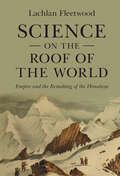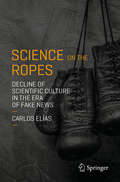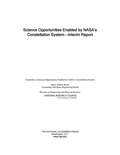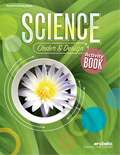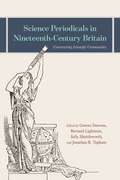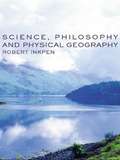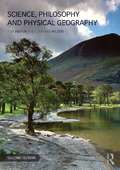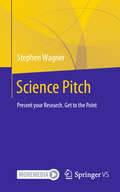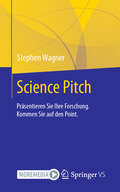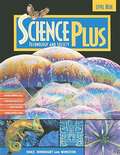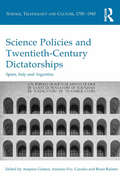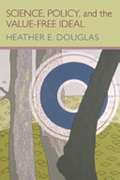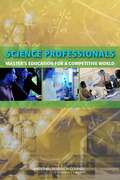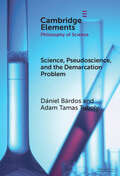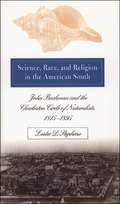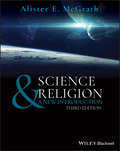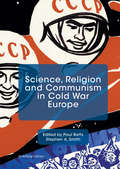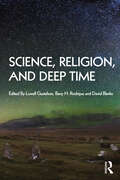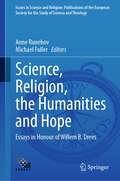- Table View
- List View
Science on the Roof of the World: Empire and the Remaking of the Himalaya (Science in History)
by Lachlan FleetwoodWhen, how, and why did the Himalaya become the highest mountains in the world? In 1800, Chimborazo in South America was believed to be the world's highest mountain, only succeeded by Mount Everest in 1856. Science on the Roof of the World tells the story of this shift, and the scientific, imaginative, and political remaking needed to fit the Himalaya into a new global scientific and environmental order. Lachlan Fleetwood traces untold stories of scientific measurement and collecting, indigenous labour and expertise, and frontier-making to provide the first comprehensive account of the East India Company's imperial entanglements with the Himalaya. To make the Himalaya knowable and globally comparable, he demonstrates that it was necessary to erase both dependence on indigenous networks and scientific uncertainties, offering an innovative way of understanding science's global history, and showing how geographical features like mountains can serve as scales for new histories of empire.
Science on the Ropes: Decline of Scientific Culture in the Era of Fake News
by Carlos ElíasIn this controversial essay, Carlos Elías addresses the worldwide phenomenon that is threatening the scientific and economic progress of Western countries. The rise and influence of magic and irrationality in the media, in social networks and at universities is a disturbing phenomenon: many Western students no longer want to pursue STEM (Science, Technologies, Engineering, and Math) careers. This lucid and well-written book addresses one of the key issues of public debate: the deteriorating state of science in Western countries and their governments, and its rise in Asian countries. The author compares two distinct models: the Spanish or Latin model, which closed the door on science with the Counter-Reformation, and that employed by a second group of countries where science was encouraged. Elías suggests that a similar development could now be taking place between Western countries (where the press, television and social science academics are becoming increasingly critical towards science) and Asia, where most prime ministers (and other politicians) are scientists or engineers. This book is intended for STEM educators (both at secondary schools and universities), scientists and academics interested in scientific culture in the era of fake news.
Science Opportunities Enabled by NASA's Constellation System--Interim Report
by National Research Council of the National AcademiesTo begin implementation of the Vision for Space Exploration (recently renamed “United States Space Exploration Policy”), NASA has begun development of new launch vehicles and a human-carrying spacecraft that are collectively called the Constellation System. In November 2007, NASA asked the NRC to evaluate the potential for the Constellation System to enable new space science opportunities. For this interim report, 11 existing “Vision Mission” studies of advanced space science mission concepts inspired by earlier NASA forward-looking studies were evaluated. The focus was to assess the concepts and group them into two categories: more-deserving or less deserving of future study. This report presents a description of the Constellation System and its opportunities for enabling new space science opportunities, and a systematic analysis of the 11 Vision Mission studies. For the final report, the NRC issued a request for information to the relevant communities to obtain ideas for other mission concepts that will be assessed by the study committee, and several issues addressed only briefly in the interim report will be explored more fully.
Science Order and Design Activity Book
by Abeka BooksDive deeper into the world of science with this fun and informative activity book! From solving a metabolic mystery crossword, labeling the anatomy of a flower, to searching for health terms in a word-hunt game, and matching the different flight patterns of birds, your child will come to love the subject of science even more. <p><p>A STEM project is also included in this book, allowing your child to perform an investigation or develop a design related to the field of science, technology, engineering, and mathematics. <p><p>Your child will develop important research skills and learn to apply the scientific method through this project. Offer your child a thorough review through the fun activities in this book. It’s a win-win solution for you and your child!
Science Periodicals in Nineteenth-Century Britain: Constructing Scientific Communities
by Gowan Dawson Bernard Lightman Sally Shuttleworth Jonathan R. TophamPeriodicals played a vital role in the developments in science and medicine that transformed nineteenth-century Britain. Proliferating from a mere handful to many hundreds of titles, they catered to audiences ranging from gentlemanly members of metropolitan societies to working-class participants in local natural history clubs. In addition to disseminating authorized scientific discovery, they fostered a sense of collective identity among their geographically dispersed and often socially disparate readers by facilitating the reciprocal interchange of ideas and information. As such, they offer privileged access into the workings of scientific communities in the period. The essays in this volume set the historical exploration of the scientific and medical periodicals of the era on a new footing, examining their precise function and role in the making of nineteenth-century science and enhancing our vision of the shifting communities and practices of science in the period. This radical rethinking of the scientific journal offers a new approach to the reconfiguration of the sciences in nineteenth-century Britain and sheds instructive light on contemporary debates about the purpose, practices, and price of scientific journals.
Science Periodicals in Nineteenth-Century Britain: Constructing Scientific Communities
by Gowan Dawson Bernard Lightman Sally Shuttleworth Jonathan R. TophamPeriodicals played a vital role in the developments in science and medicine that transformed nineteenth-century Britain. Proliferating from a mere handful to many hundreds of titles, they catered to audiences ranging from gentlemanly members of metropolitan societies to working-class participants in local natural history clubs. In addition to disseminating authorized scientific discovery, they fostered a sense of collective identity among their geographically dispersed and often socially disparate readers by facilitating the reciprocal interchange of ideas and information. As such, they offer privileged access into the workings of scientific communities in the period. The essays in this volume set the historical exploration of the scientific and medical periodicals of the era on a new footing, examining their precise function and role in the making of nineteenth-century science and enhancing our vision of the shifting communities and practices of science in the period. This radical rethinking of the scientific journal offers a new approach to the reconfiguration of the sciences in nineteenth-century Britain and sheds instructive light on contemporary debates about the purpose, practices, and price of scientific journals.
Science, Philosophy and Physical Geography
by Robert Inkpen Graham WilsonThis accessible and engaging text explores the relationship between philosophy, science and physical geography. It addresses an imbalance that exists in opinion, teaching and to a lesser extent research, between a philosophically enriched human geography and a perceived philosophically ignorant physical geography.Science, Philosophy and Physical Geography, challenges the myth that there is a single self-evident scientific method, that can and is applied in a straightforward manner by physical geographers. It demonstrates the variety of alternative philosophical perspectives. Furthermore it emphasizes the difference that the real world geographical context and the geographer make to the study of environmental phenomenon. This includes a consideration of the dynamic relationship between human and physical geography. Finally, it demonstrates the relevance of philosophy for both an understanding of published material and for the design and implementation of studies in physical geography. Key themes such as global warming, species and evolution and fluvial geomorphology are used to provide illustrations of key concepts in each chapter. Further reading is provided at the end of each chapter.
Science, Philosophy and Physical Geography
by Robert Inkpen Graham WilsonThis accessible and engaging text explores the relationship between philosophy, science and physical geography. It addresses an imbalance that exists in opinion, teaching and to a lesser extent research, between a philosophically enriched human geography and a perceived philosophically empty physical geography. The text challenges the myth that there is a single self-evident scientific method that can, and is, applied in a straightforward manner by physical geographers. It demonstrates the variety of alternative philosophical perspectives and emphasizes the difference that the real world geographical context and the geographer make to the study of environmental phenomenon. This includes a consideration of the dynamic relationship between human and physical geography. Finally, the text demonstrates the relevance of philosophy for both an understanding of published material and for the design and implementation of studies in physical geography. This edition has been fully updated with two new chapters on field studies and modelling, as well as greater discussion of ethical issues and forms of explanation. The book explores key themes such as reconstructing environmental change, species interactions and fluvial geomorphology, and is complimented throughout with case studies to illustrate concepts.
Science Pitch: Present your Research. Get to the Point
by Stephen WagnerHow can scientists present their projects with power to the point? This book is the ultimate guide for transforming complex research into captivating, convincing Science Pitches in a given time. The innovative ESPRIT model equips scientists with tools to blend professional expertise with personal passion, ensuring every presentation resonates deeply with its target audience. This concise manual combines research excellence and professionalism. It integrates artificial intelligence (AI) applications and slide design. Practice-oriented advice is enriched with real-world examples preparing for outstanding presentations. Designed for students and researchers eager to gain visibility, this book is a unique guide to getting your message across; it advances your research and engages your audience. Unlock your project’s potential and wrap expertise and passion in unique science storytelling. The Science Pitch results in a convincing short talk, successful networking, and securing funding approval for the research project. Via app: Download the SN More Media app for free, scan a link with play button and access videos directly on your smartphone or tablet.
Science Pitch: Präsentieren Sie Ihre Forschung. Kommen Sie auf den Point.
by Stephen WagnerWie können WissenschaftlerInnen ihre Projekte mit Power auf den Point präsentieren? Als ultimativer Leitfaden übersetzt dieses Buch komplexe Forschung in überzeugende Kurzvorträge. Das innovative ESPRIT-Modell gibt WissenschaftlerInnen die nötigen Tools an die Hand, um Professionalität mit Persönlichkeit zu verbinden und so ihr Zielpublikum zu überzeugen. Dieses Praxis-Handbuch integriert Anwendungen der Künstlichen Intelligenz (KI) und Foliengestaltung. Praxisorientierte Tipps mit konkreten Beispielen zeigen auf, wie Studierende und Forschende sichtbar als ExpertInnen wahrgenommen werden können. Mit diesem einzigartigen Leitfaden können sie prägnante Botschaften vermitteln sowie fachliche Expertise und persönliche Leidenschaft zu einem einzigartigen wissenschaftlichen Storytelling verbinden. Der Science Pitch ermöglicht überzeugende Kurzvorträge, erfolgreiches Networking und die Zusage von Fördermitteln für Forschungsprojekte.
Science Plus: Technology and Society (Level Green)
by Holt Rinehart WinstonTextbook focusing on technology and its effects on various branches of science.
Science Plus: Technology and Society (Level Blue)
by Holt Rinehart WinstonDevelop your Science skills using Science Plus--like observing, experimenting, and explaining observations and ideas.
Science Plus Technology and Society: Level Blue
by Charles Mcfadden Robert E. YagerThis new United States edition has been adapted from prior work by the Atlantic Science Curriculum Project, an international project linking teaching, curriculum development, and research in science education. There are many things to try, create, and to investigate--both in and out of class. There are stories to read, articles to think about, puzzles to solve, and even games to play.
Science Policies and Twentieth-Century Dictatorships: Spain, Italy and Argentina (Science, Technology and Culture, 1700-1945)
by Brian Balmer Amparo Gómez Antonio Fco. CanalesMaking a fresh contribution to the political history of science, this book explores the connections between the science policies of three countries that each experienced considerable political upheaval in the twentieth century: Spain, Italy and Argentina. By focussing on these three countries, the contributors are able to present case studies that highlight the characteristics and specificities of the democratic and dictatorial political processes involved in the production of science and technology. The focus on dictatorship presents the opportunity to expand our knowledge -beyond the more extensive literature about science in Nazi Germany and Stalinist USSR -about the level of political involvement of scientists in non-democratic contexts and to what extent they act as politicians in different contexts. Key topics covered include the new forms of organization and institutionalization of science in the twentieth century; the involvement of scientific communities in the governance of science and its institutions; the role of ideology in scientific development; the scientific practices adopted by scientific communities in different contexts; and the characteristics of science and technology produced in these contexts.
Science, Policy, And The Value-free Ideal
by Heather DouglasThe role of science in policymaking has gained unprecedented stature in the United States, raising questions about the place of science and scientific expertise in the democratic process. Some scientists have been given considerable epistemic authority in shaping policy on issues of great moral and cultural significance, and the politicizing of these issues has become highly contentious. Since World War II, most philosophers of science have purported the concept that science should be “value-free.” In Science, Policy and the Value-Free Ideal, Heather E. Douglas argues that such an ideal is neither adequate nor desirable for science. She contends that the moral responsibilities of scientists require the consideration of values even at the heart of science. She lobbies for a new ideal in which values serve an essential function throughout scientific inquiry, but where the role values play is constrained at key points, thus protecting the integrity and objectivity of science. In this vein, Douglas outlines a system for the application of values to guide scientists through points of uncertainty fraught with moral valence. Following a philosophical analysis of the historical background of science advising and the value-free ideal, Douglas defines how values should-and should not-function in science. She discusses the distinctive direct and indirect roles for values in reasoning, and outlines seven senses of objectivity, showing how each can be employed to determine the reliability of scientific claims. Douglas then uses these philosophical insights to clarify the distinction between junk science and sound science to be used in policymaking. In conclusion, she calls for greater openness on the values utilized in policymaking, and more public participation in the policymaking process, by suggesting various models for effective use of both the public and experts in key risk assessments.
Science Policy Up Close
by John H. Marburger IIIIn a career that included Presidential Science Advisor to George W. Bush, John Marburger stood on the front line of battles that pulled science deep into the political arena. Science controversies, he discovered, are never just about science. As his reflections show, science can no longer be shielded from public scrutiny and government supervision.
Science Professionals: Master's Education For A Competitive World
by National Research Council of the National AcademiesWhat are employer needs for staff trained in the natural sciences at the master's degree level? How do master's level professionals in the natural sciences contribute in the workplace? How do master's programs meet or support educational and career goals? Science Professionals: Master's Education for a Competitive World examines the answers to these and other questions regarding the role of master's education in the natural sciences. The book also focuses on student characteristics and what can be learned from efforts underway to enhance the master's in the natural sciences, particularly as a professional degree. This book is a critical tool for Congress, the federal agencies charged with carrying out the America COMPETES Act, and educational and science policy makers at the state level. Additionally, anyone with a stake in the development of professional science education (four year institutions of higher education, students, faculty, and employers) will find this book useful.
Science, Pseudoscience, and the Demarcation Problem (Elements in the Philosophy of Science)
by Dániel Bárdos Adam Tamas TubolyThis Element examines various aspects of the demarcation problem: finding a distinction between science and pseudoscience. Section 1 introduces issues surrounding pseudoscience in the recent literature. Popper's falsificationism is presented in Section 2, alongside some of its early critics, such as Thomas Kuhn and Imre Lakatos. It is followed in Section 3 by the notable criticism of the Popperian program by Larry Laudan that put the issue out of fashion for decades. Section 4 explores recent multi-criteria approaches that seek to define pseudoscience not only along a single criterion, but by considering the diversity and historical dimension of science. Section 5 introduces the problem of values (the 'new demarcation problem') and addresses how we can use values in the problem of pseudoscience. Finally, Section 6 concludes by emphasizing the need for an attitude-oriented approach over a rigid, method-based demarcation, recognizing scientific practice's evolving and multifaceted nature.
Science, Psychoanalysis, and the Brain
by Shimon MaromScience, Psychoanalysis, and the Brain is an invitation to a space for dialogue where reflections on neurophysiology are expressed with and guided by depth-psychology in mind; a space where neurophysiology resumes its traditional humbled stance towards matters of the psyche, and where the intellectual autonomy of depth psychology is acknowledged. The author leads the reader through the terrain of methodological errors that have plagued recent reductive approaches, paving the way for a dialogue that is based on an alternative, relational approach. Neurophysiology is discussed on a high level of abstraction, enabling a genuine analysis of the organization of the brain through its relational interactions with the world. In this dialogue, where psychology provides a theoretical framework that contributes to physiology, both parties benefit. Neurophysiology gains important constraints and guidance in phrasing meaningful questions, whilst psychology gains further motivation to crystalize its multifaceted concepts. Both disciplines enrich the spectrum of metaphors available to them within their own discourses.
Science, Race, and Religion in the American South
by Lester D. StephensIn the decades before the Civil War, Charleston, South Carolina, enjoyed recognition as the center of scientific activity in the South. By 1850, only three other cities in the United States--Philadelphia, Boston, and New York--exceeded Charleston in natural history studies, and the city boasted an excellent museum of natural history. Examining the scientific activities and contributions of John Bachman, Edmund Ravenel, John Edwards Holbrook, Lewis R. Gibbes, Francis S. Holmes, and John McCrady, Lester Stephens uncovers the important achievements of Charleston's circle of naturalists in a region that has conventionally been dismissed as largely devoid of scientific interests. Stephens devotes particular attention to the special problems faced by the Charleston naturalists and to the ways in which their religious and racial beliefs interacted with and shaped their scientific pursuits. In the end, he shows, cultural commitments proved stronger than scientific principles. When the South seceded from the Union in 1861, the members of the Charleston circle placed regional patriotism above science and union and supported the Confederate cause. The ensuing war had a devastating impact on the Charleston naturalists--and on science in the South. The Charleston circle never fully recovered from the blow, and a century would elapse before the South took an equal role in the pursuit of mainstream scientific research.
Science & Religion: A New Introduction (Wiley Desktop Editions Ser.)
by Alister E. McGrathThe leading introductory textbook on the study of religion and the natural sciences, including new coverage of the latest topics in the field Science and Religion provides students with a thorough introduction to the major themes and landmark debates in the interaction of science and religion. Incorporating history, philosophy, the natural sciences, and theology, this popular textbook examines how science and religion approach central questions and discusses the relationship between the two areas through the centuries. The authoritative and accessible chapters are designed for readers with minimal knowledge of science or theology. Written by one of the world’s leading authorities on the study of religion and science, this fully revised and updated third edition addresses contemporary topics and reflects the latest conceptual developments in the field. New and expanded chapters and case studies discuss Scientism, evolutionary theodicy, the Theory of Relativity, warranted belief in science and religion, the influence of science and religion on human values, and more. The most up-to-date introduction to this exciting and rapidly growing field, this textbook: Offers an engaging, thematically-based approach to the subject Provides historical context for major events in science and religion Explores scientific and religious perspectives on Creation and the existence of God Discusses models, analogies, and issues at the intersection of science and religion Is supported by a series of videos that complement each chapter One of the most respected and widely adopted textbooks in the field, Science and Religion: A New Introduction, 3rd Edition is an ideal resource for college, seminary, and university students in courses in science and religion; church or community courses in the relation of science and faith; and general readers looking for an inclusive overview of the field.
Science, Religion and Communism in Cold War Europe
by Paul Betts Stephen A. SmithReligion and science were fundamental aspects of Eastern European communist political culture from the very beginning, and remained in uneasy tension across the region over the decades. While both topics have long attracted a great deal of scholarly attention, they almost invariably have been studied discretely as separate stories. Religion, Science and Communism in Cold War Europe is the first scholarly effort to explore the delicate interface of religion, science and communism in Cold War Europe. It brings together an international team of researchers who address this relationship from a number of national viewpoints and thematic perspectives, ranging from mysticism to social science, space exploration to the socialist lifecycle, and architectural heritage to pop culture.
Science, Religion and Deep Time
by Lowell Gustafson Barry H. Rodrigue David BlanksThis book examines the meaning of religion within the scientific, evidence-based history of our known past since the big bang. While our current major religions are only centuries or millennia old, our volume discusses the origins and development of human religious practice and belief over our species’ existence of 300,000 years. The volume also connects the scientific approach to natural and social history with ancient truths of our religious ancestors using new lines of inquiry, new technologies, new modes of expression, and new concepts. It brings together insights of natural scientists, social scientists, philosophers, writers, and theologians to discuss narratives of the universe. The essays discuss that to apprehend religion scientifically, or to interpret and explain science theologically, the subject must be examined through a variety of disciplinary lenses simultaneously and raise several theoretical, philosophical, and moral problems. With a singular investigation into the meaning of religion in the context of the 13.8 billion-year history of our universe, this book will be indispensable for scholars and students of religious studies, big history, sociology and social anthropology, philosophy, and science and technology studies.
Science, Religion, the Humanities and Hope: Essays in Honour of Willem B. Drees (Issues in Science and Religion: Publications of the European Society for the Study of Science and Theology #8)
by Anne Runehov Michael FullerThis book collects a multidisciplinary range of contributions focusing on the prolific and seminal work of Willem Drees in the fields of philosophy of religion, philosophy of the humanities, and science and theology/religion. Trained in both theoretical physics and theology/philosophy of religion, Drees holds doctoral degrees in both theology and in philosophy and, amongst other distinguished positions, held professorships at the University of Leiden and at the University of Tilburg. Drees was also Editor-in-Chief of Zygon, Journal of Religion & Science, between 2008 and 2018, and served as President of the European Society for the Study of Science and Theology (ESSSAT) between 2002 and 2008. In 2018, he was elected as member of the Royal Holland Society of Sciences and Humanities (KHMW). This contributed volume builds on Drees’ expansive and provocative scholarly contributions, notably around the concept and meaning of naturalism and the humanities to the fields of science and religion, as exemplified by his works Religion, Science and Naturalism (1996) and What Are the Humanities For? (2021). In a time where more and more young people across the globe are entering higher education such cross-disciplinary explorations and (re-)evaluations are vital to the field. Accordingly, by approaching his work from a variety of disciplines this collection illuminates the broad reach of Drees’ work and provides scholars from various fields with many new and rich opportunities avenues for research.
